Chapter: 12th Physics : Magnetism and Magnetic Effects of Electric Current
Magnetic Properties
MAGNETIC PROPERTIES
All the materials we use
are not magnetic materials. Further, all the magnetic materials will not behave
identically. So, in order to differentiate one magnetic material from another,
we need to know some basic parameters. They are:
(a) Magnetising field
The magnetic field which
is used to magnetize a sample or specimen is called the magnetising field. Magnetising field is a
vector quantity and it denoted by ![]() and its unit is A m-1.
and its unit is A m-1.
(b) Magnetic permeability
The magnetic
permeability can be defined as the measure of ability of the material to
allow the passage of magnetic field lines through it or measure of the
capacity of the substance to take magnetisation or the degree of penetration of
magnetic field through the substance.
In free space, the
permeability (or absolute permeability) is denoted by µ0 and for any
medium it is denoted by µ.The relative permeability µr
is defined as the ratio between absolute permeability of the medium to the
permeability of free space.

Relative permeability is
a dimensionless number and has no units. For free space (air or vacuum), the
relative permeability is unity i.e., µr = 1. In isotropic medium, µ
is a scalar but for non-isotropic medium, µ is a tensor.
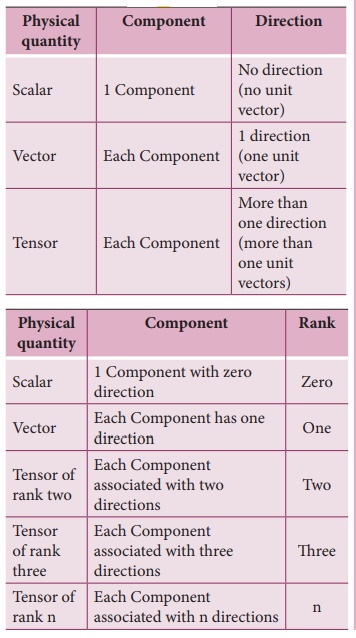
(c) Intensity of magnetisation
Any bulk material (any
object of finite size) contains a large number of atoms. Each atom consists of
electrons which undergo orbital motion. Due to orbital motion, electron has
magnetic moment which is a vector quantity. In general, these magnetic moments
orient randomly, therefore, the net magnetic moment is zero per unit volume of
the material.
When such a material is
kept in an external magnetic field, atomic dipoles are created and hence, it
will try to align partially or fully along the direction of external field. The
net magnetic moment per unit volume of the material is known as intensity of
magnetisation or magnetisation vector or magnetisation. It is a
vector quantity. Mathematically,

The SI unit of intensity
of magnetisation is ampere metre-1. For a bar magnet of pole
strength qm, length 2l and area of cross-section A, the
magnetic moment of the bar magnet is  and volume of the bar magnet is
and volume of the bar magnet is  The intensity of
magnetisation for a bar magnet is
The intensity of
magnetisation for a bar magnet is
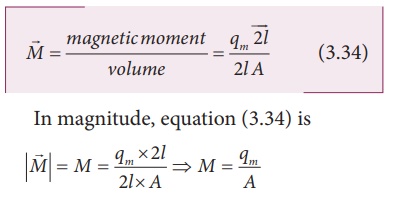
This means, for a bar
magnet the intensity of magnetisation can be defined as the pole
strength per unit area (face area).
(d) Magnetic induction or total magnetic field
When a substance like
soft iron bar is placed in an uniform magnetising field ![]() , it becomes a
magnet, which means that the substance gets magnetised. The magnetic induction
(total magnetic field) inside the specimen
, it becomes a
magnet, which means that the substance gets magnetised. The magnetic induction
(total magnetic field) inside the specimen ![]() 0 is
equal to the sum of the magnetic field
0 is
equal to the sum of the magnetic field ![]() produced in vacuum
due to the magnetising field and the magnetic field
produced in vacuum
due to the magnetising field and the magnetic field ![]() m
due to the induced magnetisation of the substance.
m
due to the induced magnetisation of the substance.

e)Magnetic susceptibility
When a substance is kept
in a magnetising field ![]() , magnetic susceptibility gives information
about how a material respond to the external (applied) magnetic field. In other
words, the magnetic susceptibility measures, how easily and how strongly a
material can be magnetised. It is defined as the ratio of the intensity of
magnetisation (
, magnetic susceptibility gives information
about how a material respond to the external (applied) magnetic field. In other
words, the magnetic susceptibility measures, how easily and how strongly a
material can be magnetised. It is defined as the ratio of the intensity of
magnetisation ( ![]() ) induced in the material due to the magnetising
field (
) induced in the material due to the magnetising
field ( ![]() )
)

It is a dimensionless
quantity. For an isotropic medium, susceptibility is a scalar but for
non-isotropic medium, susceptibility is a tensor. Magnetic susceptibility for
some of the isotropic substances is given in Table 3.1.
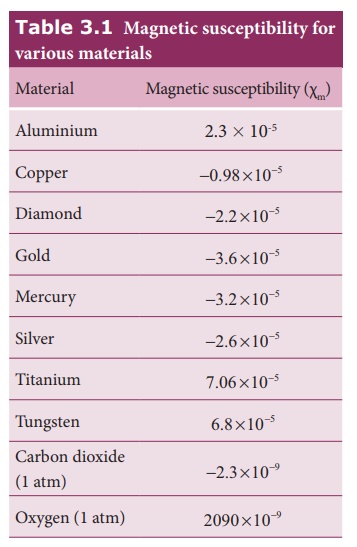
EXAMPLE 3.10
Compute the intensity of
magnetisation of the bar magnet whose
mass, magnetic moment and density are
200 g, 2 A m2 and 8 g cm-3, respectively.
Solution
Density of the magnet is
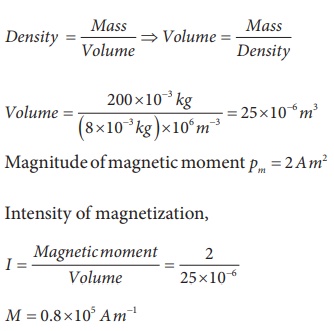
EXAMPLE 3.11
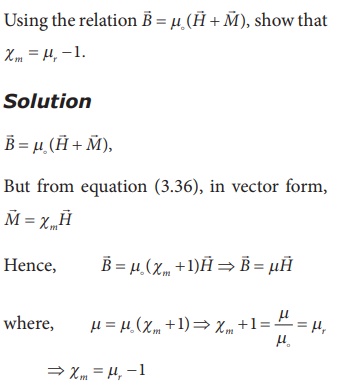
EXAMPLE 3.12
Two materials X and Y
are magnetised, whose intensity of magnetisation are 500 A m-1 and
2000 A m-1, respectively. If the magnetising field is 1000 A m-1,
then which one among these materials can be easily magnetized?.
Solution
The susceptibility of
material X is

The susceptibility of
material Y is

Since, susceptibility of material Y is greater than that of material X, material Y can be easily magnetized than X.
Related Topics